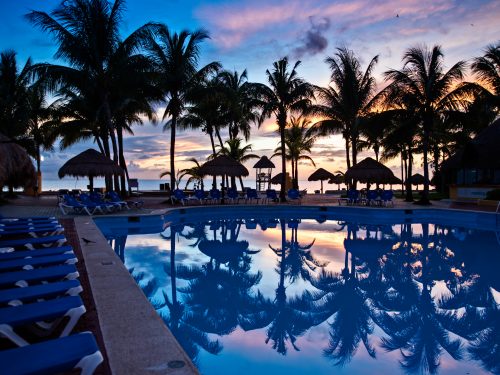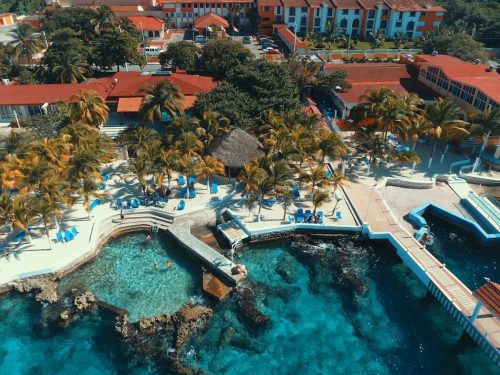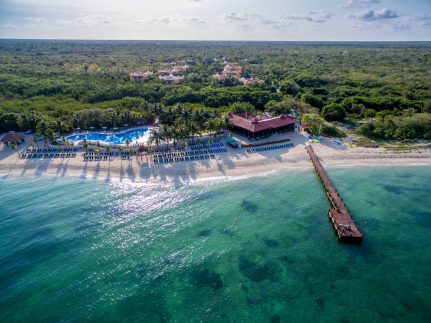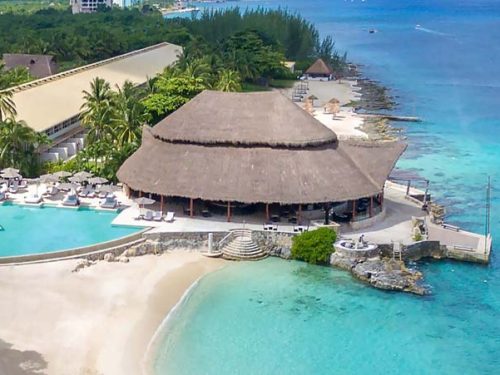Drifts To Drop-Offs
Cozumel, known to locals as the Island of the Swallows, is a year-round dive destination that offers outstanding visibility of 30-60 meters (100-200 feet), and possibly best of all: easy drift diving. Thanks to the region’s continuous ocean currents flowing through its reefs, Cozumel is effectively the drift-diving capital of the Caribbean, and offers divers a flow rate of 1 to 2 knots as they fly through its colourful coral formations.
Chankanaab Lagoon, in Chankanaab National Park, is one of Cozumel’s favourite hotspots and gives snorkelers and novice divers alike easy access to a shallow cove, where they can enjoy plentiful fish species and coral heads. Scuba divers here can also use the lagoon to access a popular offshore dive site. Santa Rosa Reef, easily accessed out of San Miguel, will take you from a float over the smooth white sands of its Shallows, to a wall featuring multiple caves and tunnels to explore. This relatively deep reef features plenty of ledges, as well as stony coral and giant sponges, and divers should keep their eyes open for turtles, giant parrotfish, and giant green moray eels. Meanwhile, the San Francisco Reef makes a great first wall dive for the less experienced scuba diver. Ranging from 10-15 meters (35-50 feet), with three separate sections divided by 45-55 meter (50-60 yard) sandy stretches, the reef is alive with various species of marine life, including rays and sea turtles. For deep wall first-timers, this drop over the edge into nothingness can be quite a memorable experience.
Jungle Cave Diving – AKA Cenotes
Freshwater Cenote diving on the mainland is a unique experience that should definitely be a part of every diving vacation in Cozumel. This can easily be done on a day trip. Over the years, rainwater has dissolved the limestone formations of the Yucatan region to such an extent that underground rivers have formed, and a huge cave system has developed, with waters flowing all the way out to the ocean. Due to ongoing erosion, the roofs of these cave systems have collapsed here and there, exposing the underground streams to the surface. At sites like the magical Cenote Dos Ojos, divers can explore these sinkholes in the jungle with only an open water certificate, and can gain access to more than 80 km (50 miles) of underwater cave systems. These caves were dry at some point during their geological development, and so beautiful formations of stalactites and stalagmites have evolved, making these sub-aquatic caves some of the most beautiful and fascinating in the world.
Getting From Here To There
As one of the best values in the Caribbean, the island of Cozumel is easily reached from most major centers, thanks to direct flights and charter flights. The Cozumel Airport offers flights in and out on a daily basis, but many visitors fly to Cancun International Airport and choose an air shuttle, water taxi, or bus and ferry option (from Playa del Carmen) to get to the island’s main town of San Miguel. Spanish is the region’s official language, but because Cozumel is such a popular tourist destination, English is widely spoken. Be advised, however, that local merchants and businesses are no longer permitted to exchange US currency for local pesos.
Water temperatures in Cozumel hold steady at an impressive range of 25-29oC (77-85oF) throughout the year, and in spite of the region’s rainy season from May through September, diving is still possible on most days, and scuba diving packages in Cozumel are plentiful. For divers and other Cozumel sightseers looking for a bit of variety, you can stay dry and explore reef formations at a depth of 30 meters (100 feet) with a local submarine company, or investigate one of the island’s ancient Mayan sites via four-wheel drive or horseback. A round of golf, nightlife in San Miguel, hanging out on one of the island’s glorious white beaches, or enjoying a mainland tour are all appealing options to be considered for those few, precious days out of the water.
Thank you to Ran Mor for the use of his images.








